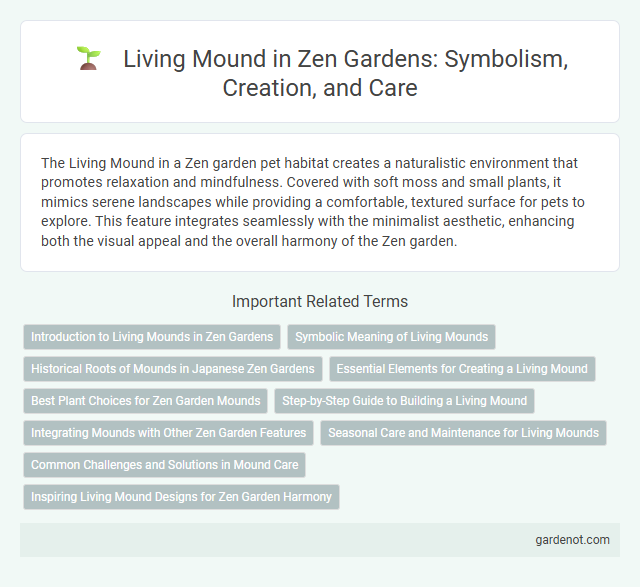The Living Mound in a Zen garden pet habitat creates a naturalistic environment that promotes relaxation and mindfulness. Covered with soft moss and small plants, it mimics serene landscapes while providing a comfortable, textured surface for pets to explore. This feature integrates seamlessly with the minimalist aesthetic, enhancing both the visual appeal and the overall harmony of the Zen garden.
Introduction to Living Mounds in Zen Gardens
Living mounds in Zen gardens are carefully shaped earth forms covered with moss, grass, or low-lying plants, symbolizing natural landscapes such as hills or islands. These mounds create a harmonious balance between solid and void, enhancing the garden's tranquil atmosphere and encouraging meditation. Their organic shape and textured surfaces contribute to the garden's overall aesthetic, representing nature's simplicity and impermanence.
Symbolic Meaning of Living Mounds
Living mounds in Zen gardens symbolize the harmonious balance between nature and human contemplation, representing mountains or islands amidst the raked gravel sea. These moss-covered elevations evoke spiritual ascendance and tranquility, inviting meditation on impermanence and the natural world's quiet strength. Their presence embodies the Zen principle of simplicity, fostering mindfulness through subtle, organic forms.
Historical Roots of Mounds in Japanese Zen Gardens
Living mounds in Japanese Zen gardens trace their historical roots to ancient Shinto and Buddhist practices, symbolizing sacred hills and spiritual landscapes. These earthen forms, often covered with moss or carefully selected plants, represent natural elements that foster meditation and harmony with nature. The integration of living mounds reflects the Zen principle of impermanence and the deep connection between garden design and contemplative experience.
Essential Elements for Creating a Living Mound
Essential elements for creating a living mound in a Zen garden include selecting native, drought-resistant plants to ensure sustainability and low maintenance. Incorporating well-draining soil layers supports healthy root growth and prevents erosion. The mound's shape should complement the garden's natural flow, enhancing harmony and balance within the landscape.
Best Plant Choices for Zen Garden Mounds
Ideal plant selections for Zen garden living mounds include low-maintenance, drought-tolerant species that enhance tranquility and texture. Japanese moss, creeping thyme, and sedum provide lush ground cover while requiring minimal care and complementing the garden's meditative aesthetic. Incorporating dwarf evergreens like hinoki cypress or juniper adds structure and year-round visual interest to the mounds.
Step-by-Step Guide to Building a Living Mound
Building a living mound in a Zen garden involves selecting native plants that thrive in your climate and layering soil with organic compost for nutrient-rich growth. Start by marking the mound's shape, then gradually sculpt the earth to create gentle slopes that promote drainage and visual harmony. Plant groundcovers and hardy shrubs strategically, ensuring they blend naturally while requiring minimal maintenance.
Integrating Mounds with Other Zen Garden Features
Living mounds in Zen gardens harmonize with surrounding features like raked gravel and stone arrangements by enhancing natural textures and visual layers. Strategic placement of moss-covered mounds near water basins or bamboo fences amplifies tranquility and organic balance. These living mounds serve as focal points that blend plant life with stone elements, promoting seamless integration and contemplative flow throughout the garden.
Seasonal Care and Maintenance for Living Mounds
Living mounds in Zen gardens require seasonal care to maintain their health and aesthetic appeal, including regular pruning to shape plants and encourage growth. Monitoring soil moisture levels and adjusting irrigation according to seasonal rainfall patterns ensures proper hydration without overwatering. Applying organic mulch during colder months protects roots from frost, while spring fertilization supports vigorous growth and vibrant foliage throughout the year.
Common Challenges and Solutions in Mound Care
Maintaining a living mound in a Zen garden often involves challenges such as soil erosion, uneven plant growth, and moisture retention issues. Addressing soil erosion requires installing proper drainage systems and using erosion control mats to stabilize the surface. Regular pruning and selecting drought-resistant plants improve growth uniformity and help maintain optimal hydration levels for a healthy living mound.
Inspiring Living Mound Designs for Zen Garden Harmony
Living mounds in Zen gardens create serene focal points by integrating moss, grasses, and small shrubs that embody natural balance and tranquility. Thoughtful arrangement of plant textures and heights on these mounds enhances the meditative atmosphere, promoting harmony between the garden and its surroundings. Incorporating subtle curves and layered greenery in the design emphasizes peaceful flow and Zen mindfulness.
Living mound Infographic

 gardenot.com
gardenot.com